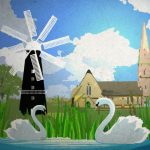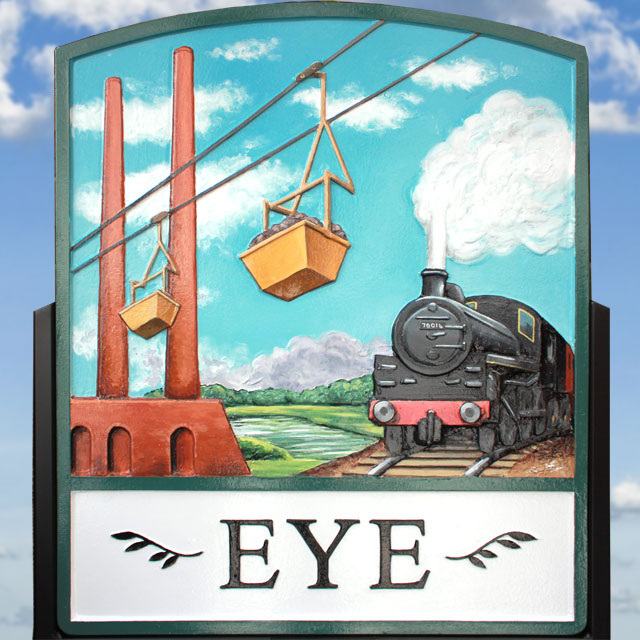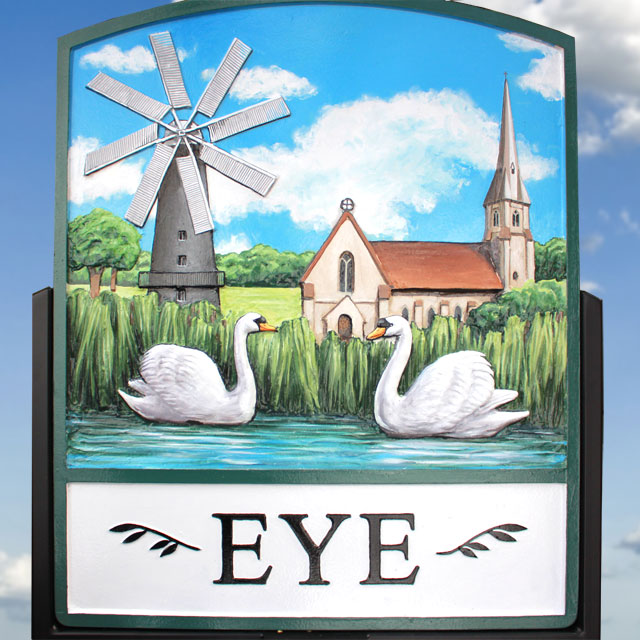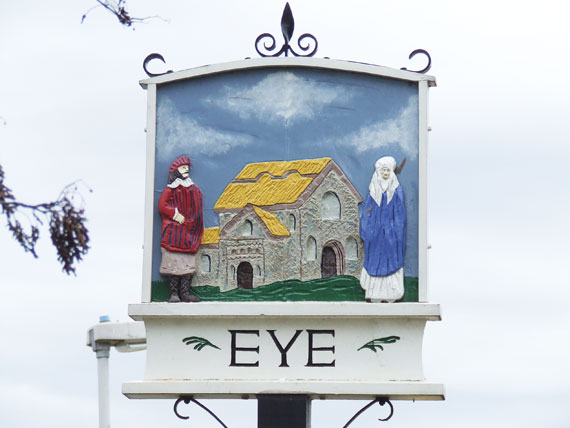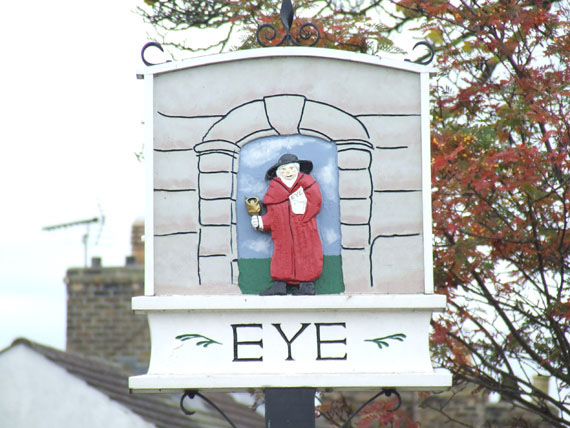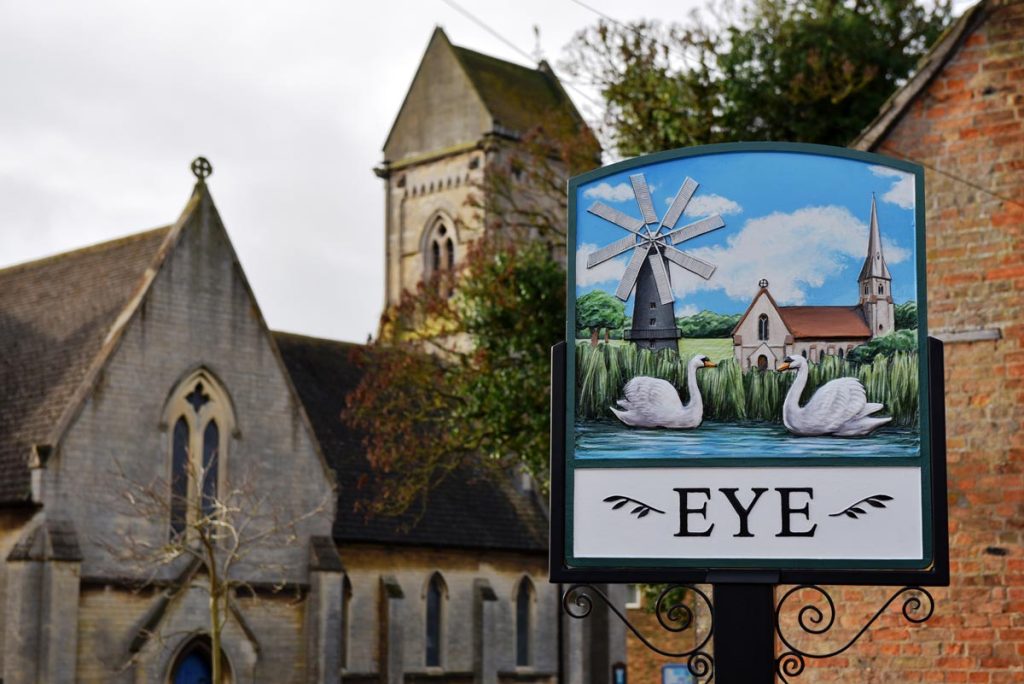
Decorative village signs date back to the time of King Edward VII (1841 – 1910). It’s believed they started in Norfolk early in the 20th century when King Edward suggested that village signs would aid motorists and give a feature of interest on the Sandringham Estate.
Village signs often depict the history and culture of the area and are an artistic representations of that past. The previous village sign1 in Eye dated back to the Queen’s Silver Jubilee in 1977 when it was installed as part of the celebrations.
The story of the new village sign for Eye starts in 2020. During a storm that year the top part of the original sign was blown off. Although it had been restored in 2008 the weather had taken it’s toll and water had managed to seep in weakening the timber structure.
This left the Parish Council with two choices, to repair the existing sign or replace it with a new one. After some discussion and inspection of the existing sign which was badly damaged and in quite a poor state they decided that it would make sense to commission a new sign. As the project progressed some ideas were drawn up and developed, leading to the sign we have today.
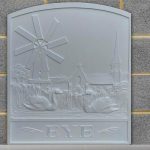 Creating the sign involves a number of steps. First a master pattern is created. Once the parish council were satisfied with the pattern it is used to create the mold. Molton metal is poured into the mold which creates a cast of the sign. Once the cast has cooled down the plaster mold is broken away leaving the cast which is cleaned up and made ready for painting.
Creating the sign involves a number of steps. First a master pattern is created. Once the parish council were satisfied with the pattern it is used to create the mold. Molton metal is poured into the mold which creates a cast of the sign. Once the cast has cooled down the plaster mold is broken away leaving the cast which is cleaned up and made ready for painting.
The final result was achieved by an artist who hand painted the scenes. The new sign was installed on Saturday 18 February 2023. You’ll find further info on what it depicts below.
The new village sign
The first side shows the eight sail windmill that was located on the site of Odam’s Mill, St Matthews Church and the swans at the nature reserve.
| Eye Tower Mill as it was known was one of only seven eight sailed windmills that were ever built in England. Heckington Windmill in Lincolnshire is the last remaining eight sail windmill and very similar to what the windmill in Eye would have looked like at it’s peak. There is nothing left of the mill today, the site where it was located is the Whitby Avenue estate. | 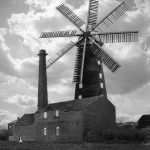 |
| Next to the windmill you can see the church with a spire. The spire was part of the church for over 120 years but it was removed in the 1980s due to safety concerns caused by large cracks that had appeared half way up. An interesting item to note is the church didn’t have the spire when it was first built in 1847, but it was added a decade later. | 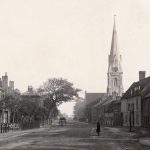 |
| Of course no sign would be complete without our resident swans at Eye Green Nature Reserve. The nature reserve was the former pit of the Northam brickworks which flooded after the it became disused. It was declared a nature reserve in 1996. |  |
The opposite side of the sign depicts the Northam Brickyard and flooded pit, the rope way and the railway that once ran across the north of the village.
| The railway line which opened in 1866 and closed in 1959 was known as the Midland and Great Northern Joint Railway. The line went from Peterborough Station through Eye then onto Sutton Bridge and Kings Lynn. The village station was located just east of where the Crowland Road/A47 roundabout is now, it was demolished to make way for the Eye bypass. | 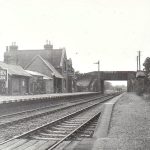 |
| The brickyard which was on Crowland Road and known as the Northam Brick Works was open for nearly 100 years. The first kilns where built in 1897 and the works eventually closed in 1990. The ropeway carried clay from the Star Pit Brick yard in Dogsthorpe to the Northam yard in Eye so the village works could continue working after the clay in the village pit had ran out. If you would like to see how it would of been when working check out this video of the last ropeway in the country at Claughton, Lancashire. Today the location of the Northam Works is the Guilsborough housing estate. |  |
Read more about any of items depicted on the sign by clicking on the links below:
- Eye Tower Mill
- St Matthew’s Church
- Eye Nature Reserve
- Northam Brickyard
- Midland and Great Northern Railway.
Footnote
1 On one side to the original village sign you had the ‘town’ crier, the last one died in the 1930s, and on the other side you had Hereward the Wake. The photos below were taken soon after the sign was renovated in 2008.
On the opposite side of the sign was Hereward the Wake (c. 1035 – 1072) and his wife Alftrude with what could be an Anglo Saxon Chapel, with a thatched roof in the background. Hereward the Wake was an 11th-century Anglo-Danish leader involved in resistance to the Norman conquest of England. I won’t go into much detail here as there’s a good article about Hereward the Wake on the Ely website here. He is known to have plundered the Abbey of Peterborough in 1070. The Anglo–Saxon Chronicle being written at the time says that among those at the sack of Peterborough were Hereward and his crew. At that time the area that became the village of Eye and surrounding lands were owned by the Cathedral.

